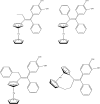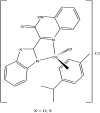Scope of organometallic compounds based on transition metal-arene systems as anticancer agents: starting from the classical paradigm to targeting multiple strategies
- PMID: 35518979
- PMCID: PMC9060267
- DOI: 10.1039/c8ra07926a
Scope of organometallic compounds based on transition metal-arene systems as anticancer agents: starting from the classical paradigm to targeting multiple strategies
Abstract
The advent of the clinically approved drug cisplatin started a new era in the design of metallodrugs for cancer chemotherapy. However, to date, there has not been much success in this field due to the persistence of some side effects and multi-drug resistance of cancer cells. In recent years, there has been increasing interest in the design of metal chemotherapeutics using organometallic complexes due to their good stability and unique properties in comparison to normal coordination complexes. Their intermediate properties between that of traditional inorganic and organic materials provide researchers with a new platform for the development of more promising cancer therapeutics. Classical metal-based drugs exert their therapeutic potential by targeting only DNA, but in the case of organometallic complexes, their molecular target is quite distinct to avoid drug resistance by cancer cells. Some organometallic drugs act by targeting a protein or inhibition of enzymes such as thioredoxin reductase (TrRx), while some target mitochondria and endoplasmic reticulum. In this review, we mainly discuss organometallic complexes of Ru, Ti, Au, Fe and Os and their mechanisms of action and how new approaches improve their therapeutic potential towards various cancer phenotypes. Herein, we discuss the role of structure-reactivity relationships in enhancing the anticancer potential of drugs for the benefit of humans both in vitro and in vivo. Besides, we also include in vivo tumor models that mimic human physiology to accelerate the development of more efficient clinical organometallic chemotherapeutics.
This journal is © The Royal Society of Chemistry.
Conflict of interest statement
There are no conflicts to declare.
Figures
































































Similar articles
-
Development and future prospects of selective organometallic compounds as anticancer drug candidates exhibiting novel modes of action.Eur J Med Chem. 2019 Aug 1;175:269-286. doi: 10.1016/j.ejmech.2019.04.062. Epub 2019 May 1. Eur J Med Chem. 2019. PMID: 31096151 Review.
-
Homo- and Hetero-dinuclear Arene-Linked Osmium(II) and Ruthenium(II) Organometallics: Probing the Impact of Metal Variation on Reactivity and Biological Activity.Chemistry. 2020 Sep 4;26(50):11593-11603. doi: 10.1002/chem.202002052. Epub 2020 Aug 7. Chemistry. 2020. PMID: 32520396
-
Next-generation anticancer metallodrugs.Curr Top Med Chem. 2012;12(3):219-35. doi: 10.2174/156802612799078964. Curr Top Med Chem. 2012. PMID: 22236158 Review.
-
Multinuclear Organometallic Ruthenium-Arene Complexes for Cancer Therapy.Met Ions Life Sci. 2018 Feb 5;18:/books/9783110470734/9783110470734-007/9783110470734-012.xml. doi: 10.1515/9783110470734-012. Met Ions Life Sci. 2018. PMID: 29394025 Review.
-
Computational Studies of Au(I) and Au(III) Anticancer MetalLodrugs: A Survey.Molecules. 2021 Dec 15;26(24):7600. doi: 10.3390/molecules26247600. Molecules. 2021. PMID: 34946684 Free PMC article. Review.
Cited by
-
Light Triggers the Antiproliferative Activity of Naphthalimide-Conjugated (η6-arene)ruthenium(II) Complexes.Int J Mol Sci. 2022 Jul 10;23(14):7624. doi: 10.3390/ijms23147624. Int J Mol Sci. 2022. PMID: 35886972 Free PMC article.
-
CuAAC "Click"-Derived Luminescent 2-(2-(4-(4-(Pyridin-2-yl)-1H-1,2,3-triazol-1-yl)butoxy)phenyl)benzo[d]thiazole-Based Ru(II)/Ir(III)/Re(I) Complexes as Anticancer Agents.ACS Omega. 2023 Aug 30;8(36):32382-32395. doi: 10.1021/acsomega.3c01639. eCollection 2023 Sep 12. ACS Omega. 2023. PMID: 37720792 Free PMC article.
-
New Tailored RNA-Targeted Organometallic Drug Candidates against Huh7 (Liver) and Du145 (Prostate) Cancer Cell Lines.ACS Omega. 2020 Jun 19;5(25):15218-15228. doi: 10.1021/acsomega.0c01206. eCollection 2020 Jun 30. ACS Omega. 2020. PMID: 32637795 Free PMC article.
-
Natural Products in Preventing Tumor Drug Resistance and Related Signaling Pathways.Molecules. 2022 May 30;27(11):3513. doi: 10.3390/molecules27113513. Molecules. 2022. PMID: 35684449 Free PMC article. Review.
-
In Silico and In Vitro Studies of 4-Hydroxycoumarin-Based Heterocyclic Enamines as Potential Anti-Tumor Agents.Molecules. 2023 Aug 2;28(15):5828. doi: 10.3390/molecules28155828. Molecules. 2023. PMID: 37570800 Free PMC article.
References
-
- Jaouen G., Bioorganometallics, Wiley-VCH, Weinheim (Germany), 2006
-
- Jaouen G. and Dyson P., in Comprehensive Organometallic Chemistry III, ed. R. H. Crabtree and D. M. P. Mingos, Elsevier Ltd., Oxford, 2007, vol. 12, p. 445
-
- Hartinger C. G. Metzler-Nolte N. Dyson P. J. Organometallics. 2012;31:5677–5685. doi: 10.1021/om300373t. - DOI
-
- Allardyce C. S. Dorcier A. Scolaro C. Dyson P. J. Appl. Organomet. Chem. 2005;19:1–10. doi: 10.1002/aoc.725. - DOI
Publication types
LinkOut - more resources
Full Text Sources
Other Literature Sources

